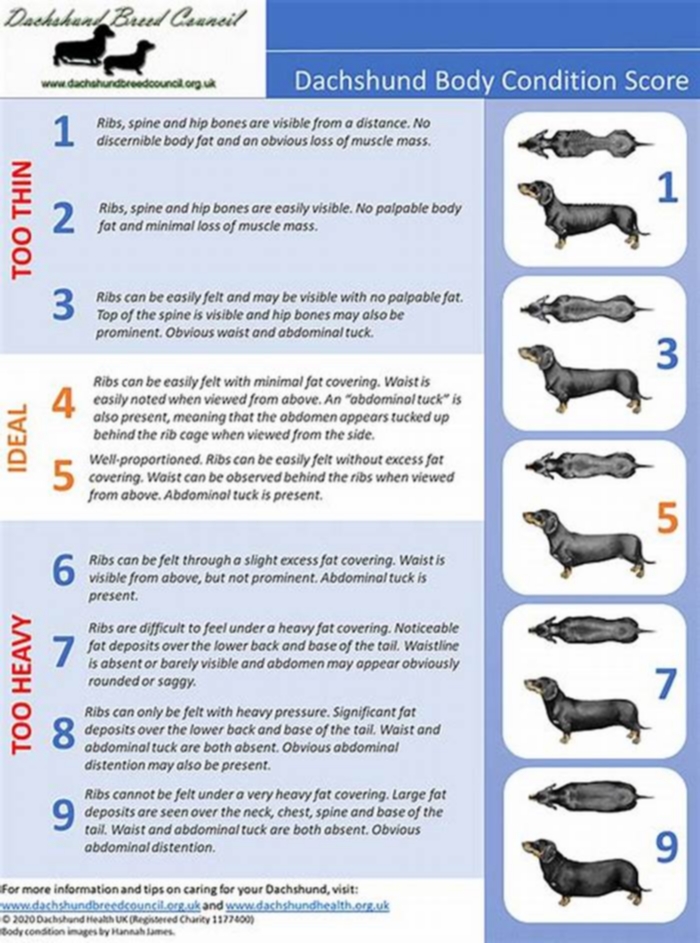Dachshund Obesity A Growing Concern Among Vets

Dachshund Obesity Is a Real Thing, But You Can Change That
How Can YouHelp Your Doxie Lose Weight?
Dachshunds can be so cute with their low-lying flappy ears and long bodies. They can even become more adorable when they become fat. They look more comical, cuddly, and huggable.
However, theres nothing cute about your overweight doxie developing serious health problems. As you know, being overweight and obese poses great health risks. It may lead to heart diseases, metabolic disorders, and maladies related to the respiratory and musculoskeletal systems.
So, if your doxie is overweight, you need to intervene as soon as you can. To get you started, here are some of the best tips you can use to help your Dachshund lose those unwanted pounds.

Diet
Obviously, you cant lose weight without talking about diet. Here are some dietary tips to start off your dogs weight loss journey.
- More protein, fewer carbohydrates dogs thrive in a high-protein diet. This helps them build lean muscles and quickly use up excess energy, which may be stored as fats.
- Avoid high-fiber food contrary to popular beliefs, high-fiber food does not help in weight loss. Your doxie wont feel satisfied and will eat more as a result. Not only that but high-fiber food may interfere with nutrient absorption.
- Dont give food scrap while it is tempting to give your adorable doxie leftovers or crumbs from the table, you need to control yourself. It doesnt just encourage bad behavior, but it can contribute to weight gain.
- Feed smaller portions of food instead of giving three large meals, your dog will lose weight faster if you give him frequently, but smaller portions of food. For example, you can divide three big meals into six small meals. Dont give in to the temptation to offer your dog a bowl full of food whenever you leave your home.

- Reduce your dogs food portion sometimes, the easiest way to lose weight is simply reducing the amount of food you feed your buddy. Now, remember not to drastically lessen your dogs food. As a general rule, reduce your dogs food by five percent for a week or two. After that, if he still doesnt lose weight, then subtract another five percent.
- Schedule your dogs eating habits dont feed your wiener dog at any time of the day. Having a scheduled mealtime will help you monitor your dogs diet. Not only that, but it reinforces discipline too.
- Track everything your dog eats while this may take more work, you will see that it produces results. Write down what you feed your dachshund as well as the amount. Weigh your dogs food and check if it conforms to your weight loss plan.

Exercise
When it comes to losing weight, diet is best coupled with exercise. It doesnt simply help your dog achieve an ideal weight, but it can help your dog become healthier and happier.
There are a lot of great forms of exercise available for your pooch. Walking your dog every morning, jogging with him, hiking, swimming, fetching, and bringing him in the park would surely burn those extra calories. Just be creative to make exercise fun and interesting. With a doxie as your dog, its easier to bring him anywhere since he is relatively small.
Make exercise a habit and schedule it as much as possible. Your dog also thrives in routine. If he routinely gets to exercise at a certain time of the day, it becomes a habit that he can continually do even after achieving his target weight.
Remember that exercise does not have to be done outside. It can be done inside your home. Just keep your pup moving and avoid being inactive. Every calorie burned counts.

Talk To Your Vet
Being overweight, or worse, obese dachshund comes with great health risks. Its a serious problem that you should not ignore. For example, an overweight doxie may easily develop back problems.
If you have an issue with the weight of your pet, it wont hurt calling your vet. He can help you create a weight loss plan, give you advice, and improve your dogs health condition.
Most importantly, read more about weight loss for dogs. The more knowledge and information you gather, the better informed you are in helping your four-legged best friend live a healthier and fuller life.

Childhood and Adolescent Obesity in the United States: A Public Health Concern
Glob Pediatr Health. 2019; 6: 2333794X19891305.
Childhood and Adolescent Obesity in the United States: A Public Health Concern
, PhD,1 , MBBS, MPH,2 , MD, PhD,3 , MD,3 and , MD3
Adekunle Sanyaolu
1Federal Ministry of Health, Abuja, Nigeria
Chuku Okorie
2Essex County College, Newark, NJ, USA
Xiaohua Qi
3Saint James School of Medicine, Anguilla, British West Indies
Jennifer Locke
3Saint James School of Medicine, Anguilla, British West Indies
Saif Rehman
3Saint James School of Medicine, Anguilla, British West Indies
1Federal Ministry of Health, Abuja, Nigeria
2Essex County College, Newark, NJ, USA
3Saint James School of Medicine, Anguilla, British West Indies
Adekunle Sanyaolu, Federal Ministry of Health, Federal Capital Territory, Abuja, Nigeria. Email:
moc.liamtoh@elnukaynasReceived 2019 Feb 12; Revised 2019 Oct 12; Accepted 2019 Nov 6.
Abstract
Childhood and adolescent obesity have reached epidemic levels in the United States. Currently, about 17% of US children are presenting with obesity. Obesity can affect all aspects of the children including their psychological as well as cardiovascular health; also, their overall physical health is affected. The association between obesity and other conditions makes it a public health concern for children and adolescents. Due to the increase in the prevalence of obesity among children, a variety of research studies have been conducted to discover what associations and risk factors increase the probability that a child will present with obesity. While a complete picture of all the risk factors associated with obesity remains elusive, the combination of diet, exercise, physiological factors, and psychological factors is important in the control and prevention of childhood obesity; thus, all researchers agree that prevention is the key strategy for controlling the current problem. Primary prevention methods are aimed at educating the child and family, as well as encouraging appropriate diet and exercise from a young age through adulthood, while secondary prevention is targeted at lessening the effect of childhood obesity to prevent the child from continuing the unhealthy habits and obesity into adulthood. A combination of both primary and secondary prevention is necessary to achieve the best results. This review article highlights the health implications including physiological and psychological factors comorbidities, as well as the epidemiology, risk factors, prevention, and control of childhood and adolescent obesity in the United States.
Keywords: obesity, childhood, adolescents, United States, body mass index, BMI
Introduction
Childhood and adolescent obesity have reached epidemic levels in the United States, affecting the lives of millions of people. In the past 3 decades, the prevalence of childhood obesity has more than doubled in children and tripled in adolescents.1 The latest data from the National Health and Nutrition Examination Survey show that the prevalence of obesity among US children and adolescents was 18.5% in 2015-2016. Overall, the prevalence of obesity among adolescents (12-19 years; 20.6%) and school-aged children (6-11 years; 18.4%) was higher than among preschool-aged children (2-5 years; 13.9%). School-aged boys (20.4%) had a higher prevalence of obesity than preschool-aged boys (14.3%). Adolescent girls (20.9%) had a higher prevalence of obesity than preschool-aged girls (13.5%; ).1 Moreover, the rates of obesity have been steadily rising from 1999-2000 through 2015-2016 ().1 According to Ahmad et al, 80% of adolescents aged 10 to 14 years, 25% of children younger than the age of 5 years, and 50% of children aged 6 to 9 years with obesity are at risk of remaining adults with obesity.2
Prevalence of obesity among children and adolescents aged 2 to 19 years, by sex and age: the United States, 2015-2016.
Trends in obesity prevalence among children and adolescents aged 2 to 19 years: the United States, 1999-2000 through 2015-2016.
Obesity can affect all aspects of children and adolescents including but not limited to their psychological health and cardiovascular health and also their overall physical health.3 The association between obesity and morbid outcomes makes it a public health concern for children and adolescents.4 Obesity has an enormous impact on both physical and psychological health. Consequently, it is associated with several comorbidity conditions such as hypertension, hyperlipidemia, diabetes, sleep apnea, poor self-esteem, and even serious forms of depression.5 In addition, children with obesity who were followed-up to adulthood were much more likely to suffer from cardiovascular and digestive diseases.3 The increase in body fat also exposes the children to increase in the risk of numerous forms of cancers, such as breast, colon, esophageal, kidney, and pancreatic cancers.6
Due to its public health significance, the increasing trend in childhood obesity needs to be closely monitored.7 However, these trends have proved to be challenging to quantify and compare. While there are many factors and areas to consider when discussing obesity in children and adolescents, there are a few trends that are evident in recent studies. For example, the prevalence of obesity varies among ethnic groups, age, sex, education levels, and socioeconomic status. A report published by the National Center for Health Statistics using data from the National Health and Nutrition Examination Survey provides the most recent national estimates from 2015 to 2016 on obesity prevalence by sex, age, race, and overall estimates from 1999-2000 through 2015-2016.1 Prevalence of obesity among non-Hispanic black (22.0%) and Hispanic (25.8%) children and adolescents aged 2 to 19 years was higher than among both non-Hispanic white (14.1%) and non-Hispanic Asian (11.0%) children and adolescents. There were no significant differences in the prevalence of obesity between non-Hispanic white and non-Hispanic Asian children and adolescents or between non-Hispanic black and Hispanic children and adolescents. The pattern among girls was similar to the pattern in all children and adolescents. The prevalence of obesity was 25.1% in non-Hispanic black, 23.6% in Hispanic, 13.5% in non-Hispanic white, and 10.1% in non-Hispanic Asian girls. The pattern among boys was similar to the pattern in all children and adolescents except that Hispanic boys (28.0%) had a higher prevalence of obesity than non-Hispanic black boys (19.0%; ).1 This review article is aimed at studying the health implications including physical and psychological factors and comorbidities, as well as the epidemiology, risk factors, prevention, and control of childhood and adolescent obesity in the United States.
Prevalence of obesity among children and adolescents aged 2 to 19 years, by sex and race and Hispanic origin: the United States, 2015-2016.
Methodology
We performed a literature search using online electronic databases (PubMed, MedlinePlus, Mendeley, Google Scholar, Research Gate, Global Health, and Scopus) using the keywords childhood, adolescents, obesity, BMI, and overweight. Articles were retrieved and selected based on relevance to the research question.
Ethical Approval and Informed Consent
Ethics approval and informed consent were not required for this narrative review.
Definition of Childhood Obesity
Defining obesity requires a suitable measurement of body fat and an appropriate cutoff range.8 Body mass index (BMI) was calculated as weight in kilograms divided by height in meters squared, rounded to 1 decimal place. Obesity in children and adolescents was defined as a BMI of greater than or equal to the age- and sex-specific 95th percentile and overweight with a BMI between the 85th and 95th percentiles of the 2000 Centers for Disease Control and Prevention (CDC) growth charts.9
However, the use of the BMI percentile according to the age/sex of the CDC growth charts for very high BMIs can result in estimates that differ substantially from those that are observed,10,11 and this constrains the maximum BMI that is attainable at given sex and age.12,13 These limitations have resulted in the classification of severe obesity as a BMI 120% of the 95th percentile rather than a percentile greater than the 95th percentile.11,14 A BMI of 120% of the 95th percentile corresponds to a BMI of ~35 among 16 to 18 year olds.
Physiology of Energy Regulation and Obesity
Obesity is a chronic multifactorial disease, characterized by an excessive accumulation of adipose tissue, commonly as a result of excessive food intake and/or low energy expenditure. Obesity can be triggered by genetic, psychological, lifestyle, nutritional, environmental, and hormonal factors.15
Obesity is found in individuals that are susceptible genetically and involves the biological defense of an elevated body fat mass, the mechanism of which could be explained in part by interactions between brain reward and homeostatic circuits, inflammatory signaling, accumulation of lipid metabolites, or other mechanisms that impair hypothalamic neurons.16
Normal energy regulation physiology is under tight neurohormonal control. The neurohormonal control is performed in the central nervous system through neuroendocrine connections, in which circulating peripheral hormones, such as leptin and insulin, provide signals to specialized neurons of the hypothalamus reflecting body fat stores and induces appropriate responses to maintain the stability of these stores. The hypothalamic region is where the center of the regulation of hunger and satiety is located. Some of them target the activity of endogenous peptides, such as ghrelin, pancreatic polypeptide,17 peptide YY, and neuropeptide Y,18 as well as their receptors.
The physiology of energy regulation may result in obesity in susceptible people when it goes awry from genetic and environmental modulators. There is strong evidence of the majority of obesity cases that are associated with central resistance to both leptin and insulin actions.19,20 The environmental modulators equally play critical roles in obesity. Changes in the circadian clock are associated with temporal alterations in feeding behavior and increased weight gain.21 Stress interferes with cognitive processes such as executive function and self-regulation. Second, stress can affect behavior by inducing overeating and consumption of foods that are high in calories, fat, or sugar; by decreasing physical activity; and by shortening sleep. Third, stress triggers physiological changes in the hypothalamic-pituitary-adrenal axis, reward processing in the brain, and possibly the gut microbiome. Finally, stress can stimulate the production of biochemical hormones and peptides such as leptin, ghrelin, and neuropeptide Y.17
The lateral hypothalamus (LH) plays a fundamental role in regulating feeding and reward-related behaviors; however, the contributions of neuronal subpopulations in the LH are yet to be identified thoroughly.22 The LH has also been associated with other aspects of body weight regulation, such as physical activity and thermogenesis.23 The LH contains a heterogeneous assembly of neuronal cell populations, in which -aminobutyric acid (GABA) neurons predominate.23 LH GABA neurons are known to mediate multiple behaviors important for body weight regulation, thus altering energy expenditure.23
Etiology and Risk Factors
Excess body fat is a major health concern in childhood and adolescent populations. The dramatic increase in childhood obesity foreshadows the serious health consequences of their adult life. As obesity begins from childhood and spans through adult life, it becomes increasingly more difficult to treat successfully. Being able to identify the risk factors and potential causes of childhood obesity is one of the best strategies for preventing the epidemic.24
According to the Morbidity and Mortality Weekly Report released in 2011, there is an acceptance that there is no single cause of childhood obesity and that energy imbalance is just a part of the numerous factors.25 Many children have a discrepancy between what is taken in and what is expended.26 For example, children with obesity consume approximately 1000 calories more than what is necessary for their body to function healthily and to be able to participate in regular physical activities. Over 10 years, there will be an excess of 57 pounds of unnecessary weight. With excessive caloric intake, as well as sedentary lifestyles, childhood obesity will continue to rise if no changes are implemented. Adding daily physical activity, better sleep patterns, as well as dietary changes can help decrease the number of excess calories and help with obesity-related problems in the future.
Also, during childhood, excess fat accumulates when the increase in caloric intake exceeds the total energy expenditure.26 Furthermore, children living in the United States today compared with children living in the 1900s are participating in more than 6 hours per day activities on social media. This includes but is not limited to traditional television, video gaming, and blogging/Facebook activities. An additional economic rationalization for the increase in childhood obesity is technology. In other words, Americans can now eat more in less time.
In a study, Cutler et al found that an increase in consumption of food tends to be related to technology innovation in food production and transportation. Technology has thus made it increasingly possible for firms to mass prepare food and ship to consumers for ready consumption, thereby taking advantage of scale economies in food preparation. The result of this change has been a significant reduction in the time costs for food production. These lower time costs have led to increased food consumption and, ultimately, increased weights.27 Eliminating the time cost of food preparation disproportionately increases consumption for hyperbolic discounters because time delay is a particularly important mechanism for discouraging those individuals from consuming.27 Society today prefers immediate satisfaction with regard to food and convenience over the long-term goals of living a long, healthy life. The availability of high-caloric, less-expensive food coupled with the extensive advertisement and easy accessibility of these foods has contributed immensely to the rising trend of obesity.28 For example, there have been reductions in the price of McDonalds and Coca-Cola (5.44% and 34.89%, respectively) between 1990 and 2007, while there was about a 17% increase in the price of fruits and vegetables between 1997 and 2003.29
Likewise, only 16% of children walk or bike to school today as compared with 42% in the late 1960s. However, the distance, convenience, weather, scanty sidewalks, and anxiety about crimes against children could all contribute to this difference. Furthermore, with elementary, middle, and high school combined, only 13.8% of these schools provide adequate daily physical education classes for at least 4 hours a week.30
Some other potential risk factors have been reported through research studies that involve issues that affect the child in utero and childhood. represents potential risk factors and confounders of childhood obesity.31
Table 1.
Potential Risk Factors of Childhood Obesity.
| Family characteristics | Parents BMI during pregnancy |
| Number of siblings of the child at 18 months | |
| The ethnicity of the child | |
| Age of the mother at delivery | |
| Childhood lifestyle | Time spent watching TV |
| Time in the car per day (weekdays/weekend) | |
| Duration of night sleep | |
| Dietary pattern | |
| Infant feeding | Breast feeding/formula feeding |
| Age of introduction to solid foods | |
| Intrauterine and perinatal factors | Birthweight |
| Sex | |
| Maternal parity | |
| Maternal smoking during pregnancy (28-32 weeks) | |
| Season of birth (winter, summer, fall, spring) | |
| Number of fetuses | |
| Other | Maternal social class (SES) |
| Maternal education | |
| Energy intake of the child |
Catalano et al argues that maternal BMI before conception, independent of maternal glucose status or birth weight, is a strong predictor of childhood obesity.32 Infants at the highest quarter for weight at 8 and 18 months are more likely to become children with obesity at age 7, than children in the lower quarters. Certain behaviors have been linked to childhood obesity and overweight; these are a lack of physical activity and unhealthy eating patterns (eating more food away from home, drinking more sugar-sweetened drinks, and snacking more frequently), resulting in excess energy intake.22,31 In addition, when one parent presents with obesity, there is an increased potential for the child to become obese over the years. Naturally, the risk is higher for the children when both parents present with obesity. Furthermore, a study that followed children over time observed that children who got less sleep <10.5 hours at age 3 were 45% more likely to be children with obesity at the age of 7, than children who got greater than 12 hours of sleep during their first 3 years of life.33,34
While all the above-mentioned factors are informative, there is still the need for further research concerning childhood and adolescent obesity and obesity in general. Risk factors for obesity in childhood are still somewhat uncertain, and evidence-based research for preventative strategies is lacking. Moreover, effective action to prevent the childhood obesity epidemic requires evidence-based on early life risk factors, and this evidence, unfortunately, is still incomplete. Furthermore, a research study has attempted to capture the complete picture of childhood obesity early life course risk factors. In the study, they identified that parental BMI and gestational weight gain among other factors should be considered in prevention programs.35
Health Effects of Childhood Obesity
Childhood obesity is known to have a significant impact on both physical and psychological health. Sahoo et al stated that childhood obesity can profoundly affect childrens physical health, social and emotional well-being, as well as self-esteem. They associated poor academic performance and a lower quality of life experienced by the child with childhood obesity. They also stated that metabolic, cardiovascular, orthopedic, neurological, hepatic, pulmonary, and menstrual disorders among others are consequences of childhood obesity.36 There are many health consequences of childhood obesity, and three of the more common ones are sleep apnea, diabetes, and cardiovascular diseases.36
Psychological Consequences of Obesity
Several studies related to childhood and adolescent obesity have focused primarily on physiological consequences. Other studies have been conducted regarding the association between psychiatric disorders and obesity; these have resulted in conflict due to obesity being found to be an insignificant factor for psychopathology. However, a comparative study by Britz et al found that high rates of mood, anxiety, somatoform, and eating disorders were detected among children with obesity. The study also observed that most psychiatric disorders began after the onset of obesity. In this large population-based study, it was found that a staggering 60% of females and 35% of males reported that they have engaged in binge eating and expressed a lack of control over their diet.37
Goldfield et al conducted a study among 1400 adolescents with obesity, overweight, and normal weight in grades 7 to 12. Their BMIs, as determined by the International Obesity Task Force, were the criteria used to define each group. Each participant completed a questionnaire on body images, eating behaviors, and moods. Adolescents with obesity reported significantly higher body dissatisfaction, social isolation, depression symptoms, anhedonia, and negative self-esteem than those of normal weight.38 There is widespread stigmatization of people with obesity that causes harm rather than the intention to motivate people to lose weight. Stigma contributes to behaviors such as binge eating, social isolation, avoidance of health care services, decreased physical activity, and increased weight gain, which worsens obesity and creates additional barriers to healthy behavior change.39 Weight-based bullying in youth is considered a common, serious problem in many countries.40 In a study conducted by OBrien et al, to test whether the association between weight stigma experiences and disordered eating behaviors, that is, emotional eating, uncontrolled eating, and loss-of-control eating, are mediated by weight bias internalization and psychological distress among 634 undergraduate university students, and results of statistical analyses showed that weight stigma was significantly associated with all measures of disordered eating, and with weight bias internalization and psychological distress.41
Asthma and Obesity
There is mounting evidence that childhood obesity is a risk factor for the development of asthma.42 A research study was conducted by Belamarich et al to investigate 1322 children aged 4 to 9 years with asthma. Obesity, as defined by the CDC, is the BMI, with weight and height being greater than the 95th percentile. This was the criteria used to identify the 249 children with obesity, while the BMI between the 5th and 95th percentile identified the children who were not obese. After a baseline assessment was done, the 9-month study found that the children with obesity had a higher number of days of wheezing over 2 weeks (4.0 vs 3.4) and as well had more unscheduled emergency hospital visits (39% vs 31%).42
Obesity directly correlates with the severity of asthma, as well as poor response to corticosteroids.43 In fact, children with obesity who also have a history of asthma are more challenging to control and linked to worse quality of life.44 A prospective trial found that weight loss in patients with obesity and a history of asthma can significantly aid them to control the asthma attacks.43
Chronic Inflammation and Childhood Obesity
Lumeng and Saltiel reported that obesity in children affects multiple organ systems and predisposes them to diseases. The effect of obesity on the tissue can manifest in the development of insulin-resistant type 2 diabetes, the risk of cancer, and pulmonary diseases.45
The inflammatory response to obesity triggers pathogens, systematic increases in circulatory inflammatory cytokines, and acute-phase reactants (eg, C-reactive proteins), which inflames the tissues. This is often caused by the activation of tissue leukocytes. Chronic inflammation in children with obesity can induce meta-inflammation that is unique when compared with other inflammatory paradigms (eg, infection, autoimmune diseases).45 Researchers have reported that children with obesity are at risk of lifelong meta-inflammation. In these children, the inflammatory markers are elevated as early as in the third year of life.45,46 This has been linked to heart disease later in life.19 The long-term consequences of such findings can cause cumulative vascular damage that correlates with the increased weight status.47
The short-term and long-term effects of obesity on the health of children is a significant concern because of the negative psychological and health consequences.46 The potential negative psychological outcomes are depressive symptoms, poor body image, low self-esteem, a risk for eating disorders, and behavior and learning problems. Additional negative health consequences include insulin resistance, type 2 diabetes, asthma, hypertension, high total, and low-density lipoprotein cholesterol and triglyceride levels in the blood, low high-density lipoprotein cholesterol levels in the blood, sleep apnea, early puberty, orthopedic problems, and nonalcoholic steatohepatitis46,47 (). Children with obesity are more likely to become adults with obesity, thus increasing their risk for several diseases before they even reach their teen years.48
Comorbidities and potential health consequences of childhood obesity.47
Prevention and Control
There are two primary components to the prevention and control of childhood obesity.
The first is to educate parents on proper nutritional requirements for their children and the second is to implement the learned information. Educating parents on proper nutrition and dietary caloric intake requirements for their children is at the forefront for the prevention of obesity; however, the way the information is disseminated may affect the usefulness of the information. For example, one of the main limitations to the education of parents about childhood obesity is that typically written information is used as the conduit to health information and disease prevention.49 The Growing Right Onto Wellness (GROW) trial used a systematic assessment of patient education material that was used for the prevention of childhood obesity in the low health literate population.49 Results suggest that the average readability is of grade 6 level (SMOG [Simple Measure of Gobbledygook] Index 5.63 0.76 and Fry graph 6.0 0.85) and that adjustment of education material must be done for low health literate populations to adequately comprehend educational material and maintain motivation on the prevention of childhood obesity.49 A similar study was conducted to further support this improvement when using color-coordinated diagrams to help parents visualize instead of trying to comprehend with numbers and words. It proved to be successful as parents were able to see where they were going wrong and make the necessary changes in their childrens diet.49
Similarly, the National Institute of Child Health and Human Development Study of Early Child Care and Youth Development conducted a study on 744 adolescents and parents, and analyzed data to determine if parental (maternal and paternal, individually) reactions to childrens behavior was related to childhood obesity.50 The study concluded that informing parents that their attitude toward their childrens behaviors will play a prominent role in preventing childhood obesity.50 Parental education on nutrition, health, and the involvement of politicians, physicians, and school personnel are key for the prevention of childhood obesity. However, community and educational institutions have begun legislating and incorporating programs such as providing healthy foods at schools and also health information sessions directed toward young individuals, aimed at preventing childhood obesity in the United States and Canada.51
Another effective prevention measure against childhood obesity is the awareness of parents on the meal and snack portion sizes. In a systematic review conducted on the effects of portion size manipulation with children and portion education/training interventions on dietary intake with parents, it was determined that the ability of adults to accurately estimate portion size improved following education/training.52 Education of parents and children on diet requirements has its limitations in that the information must be easy to understand and be easily accessible in order to be practical. Making the available education materials easier to understand from just tables and numbers to more relatable aspects such as colors or figures, parents were able to visualize the changes they need to make whether it is with regard to portion sizes or even seeing how much childhood obesity is present in their family. Although much of the literature provided to parents is targeted to help those with lower numeracy skills, many parents benefited from the information being comparative from right/wrong and good/bad with regard to dieting.49
The study recommended that proper educational materials, including useful and understandable literature, be used to control meal portion sizes and to help parents identify when children are at risk of obesity. Similarly, healthy eating practices should be taught by schools as a mandatory and essential method in the prevention of childhood obesity.52
The implementation of healthy eating practices and adequate exercise regimes are essential in the prevention and control of childhood obesity. For example, information from systematic reviews, randomized controlled trials, and well-designed observational studies indicate that evidence-based prevention and control of childhood obesity can be accomplished with the collaboration of community/school, primary health care, and home-based/family-based interventions that involve both physical activity and dietary component.53 In particular, the control of children with obesity is of significant value, as is the prevention of obesity. Two randomized control trials of 182 families were conducted from November 2005 to September 2007, and they studied the efficacy of US pediatric obesity treatment guidelines in children aged 4 to 9 years with a standardized BMI (ZBMI) greater than the 85 percentile.54 Briefly, Trial 1 studied the impact on ZBMI by reducing snack foods and sugar-sweetened beverages and increasing fruits, vegetables, and low-fat dairy.54 Trial 2 studied the impact on ZBMI by decreasing sugar-sweetened beverages and increasing physical activity and increasing low-fat milk consumption and reducing television watching. In Trial 1, the resulting ZBMI reduced within 6 months, and this was maintained through to the 12th month (ZBMI 0-12 months = 0.12 0.22).53 In Trial 2, the resulting ZBMI reduced within 6 months and continued to improve till the 12 months (ZBMI 0-12 months = 0.16 0.31).50
A similar cluster-randomized trial in England studied the effects of the reduction of carbonated beverages on the number of children with obesity in 29 classes (644 children).51 Results indicate that a decrease of 0.6 glasses of carbonated drinks (250 mL) over three days per week decreased the number of children with obesity by 0.2%, while the control group increased by 7.5% (mean difference = 7.7%, 2.2% to 13.1%) at 12 months. However, diet control is only one component of the control and prevention of childhood obesity, while adequate exercise is another.55
A systematic review and meta-analyses of the impact of diet and exercise programs (single or combined) was done on their effects on metabolic risk reduction in the pediatric population.56 Analyses indicated that the addition of exercise to dietary intervention led to greater improvements in the levels of high-density lipoprotein cholesterol (3.86 mg/dL; 95% confidence interval [CI] = 2.70 to 4.63), fasting glucose (2.16 mg/dL; 95% CI = 3.78 to 0.72), and fasting insulin (2.75 IU/mL; 95% CI = 4.50 to 1.00) over 6 months.56 Diet and exercise are both important factors in the control and prevention of childhood obesity. It is our recommendation that parents and community (teachers and doctors) should be involved in identifying children at risk based on their BMI and participate in implementing practices such as good diet control through the reduction of sugary drinks, fatty foods, and also encouraging safe exercise programs to prevent and control childhood obesity in the society.56
While all of the previous data express the more obvious prevention methods with regard to childhood obesity, it is imperative to note that ensuring that the whole family is involved in the intervention will yield the greatest results.2 All current studies indicate that families must be included in childhood treatment of obesity. However, for the success of the childs weight loss program, it is vital that the parents understand that the causes of obesity are often a mixture of four factors: genetic causes, parental habits, overeating, and poor exercise habits. Thus, instilling some responsibility on the parents and informing them that controlled food preparation, diet control, and family participation in physical activities will all assist in the treatment and control of obesity in their children.2
Childhood obesity has increased significantly in recent decades and has quickly become a public health crisis in the United States and all over the world. Its increase in prevalence has provoked widespread research efforts to identify the factors that contributed to these changes.57 Obesity starts with an imbalance between caloric intake and caloric expenditure.58 Children with obesity are at greater risk of adult obesity; therefore, if we can educate and improve the health habits of families even before they start having children, this can help reduce the increasing rate of childhood obesity in the United States. Parents and caregivers with proper education on the causes and consequences of childhood obesity can help prevent childhood obesity by providing healthy meals and snacks, daily physical activity, and nutrition education to their family members.59 Families need to take the approach of not adapting to their family being on a diet but more of a healthy lifestyle. A familys home environment can influence children at a young age; therefore, making changes starting in the household early can educate and influence them to grow up healthy. Although prevention programs may be more expensive in the short term, the long-term benefits acquired through prevention are much more likely to save an even greater amount of health care costs. Not only will the children have a better childhood and self-esteem, but prevention programs can also decrease the incidence of cardiovascular diseases, diabetes, stroke, and possibly cancers in adulthood.60 The overall need to decrease the obesity rate will help children and their families in the generations to come by building a healthy lifestyle and environment. In order to tackle the climbing obesity rate, overall health and lifestyle needs to be a priority as they balance one with the other.49 While effective interventions to thwart childhood obesity still remain elusive, the sustainability of the interventions already in place will enable children and their families to adopt these important health behaviors as lifelong practices and improve their health.58
Treatment of Obesity and the Physiology of Energy Regulation
As discussed previously, a variety of mechanisms participate in weight regulation and the development of obesity in children, including genetics, developmental influences (metabolic programming or epigenetics), individual and family health behaviors, and environmental factors. Among these potential mechanisms, only environmental factors are potentially modifiable during childhood and adolescence.
Unfortunately, despite intensive lifestyle modifications and support for healthy practices within the childrens environment, some children will continue to struggle with extreme excess weight and associated comorbidities.61,62 Therefore, a combination of pharmacotherapy and lifestyle modification can be considered.61 Overweight children should not be treated with medications unless significant, severe comorbidities persist despite lifestyle modification. The use of pharmacotherapy should also be considered in overweight children with a strong family history of type 2 diabetes or cardiovascular risk factors. Constant bidirectional communication between the brain and the gastrointestinal tract, as well as the brain and other relevant tissues (ie, adipose tissue, pancreas, and liver), ensures that the brain constantly perceives and responds accordingly to the energy status/needs of the body. This elegant biological system is subject to disruption by a toxic obesogenic environment, leading to syndromes such as leptin and insulin resistance, and ultimately further exposing individuals who are obese to further weight gain and type 2 diabetes mellitus. Currently, the only Food and Drug Administrationapproved prescription drug indicated for the treatment of pediatric obesity is orlistat (Xenical; Genentech USA, Inc, South San Francisco, CA).63 Orlistat works by inhibiting gastric and pancreatic lipases, the enzymes that break down triglycerides in the intestine. Moreover, imaging studies in humans are beginning to examine the influence that higher- order/hedonic brain regions have on homeostatic areas, as well as their responsiveness to homeostatic peripheral signals. With a greater understanding of these mechanisms, the field moves closer to understanding and eventually treating the casualties of obesity.
Conclusion
The number of children with obesity in the United States has increased substantially over the years; due to its public health significance, the increasing trends need to be closely monitored. While a complete picture of all the risk factors associated with obesity remains elusive, many of the studies agreed that prevention is the key strategy for controlling the current problem. Since the combination of diet, exercise, and physiological and psychological factors are all important factors in the control and prevention of childhood obesity, primary prevention methods should be aimed at educating the child and family and encouraging appropriate diet and exercise from a young age through adulthood while secondary prevention should be targeted at lessening the effect of childhood obesity by preventing the child from continuing unhealthy habits and obesity into adulthood. A combination of primary and secondary prevention is necessary to achieve the best results. Thus, a combined implementation of both types of preventions can significantly help lower the current prevalence of childhood and adolescent obesity in the United States. Failure to take appropriate actions could lead to serious public health consequences.
Footnotes
Contributed by
Author Contributions: AS: Contributed to conception and design; drafted manuscript; gave final approval; agrees to be accountable for all aspects of work ensuring integrity and accuracy.
CO: Contributed to conception and design; agrees to be accountable for all aspects of work ensuring integrity and accuracy.
XQ: Contributed to the acquisition, analysis, and interpretation.
JL: Contributed to the acquisition, analysis, and interpretation.
SR: Contributed to the acquisition, analysis, and interpretation.
Declaration of Conflicting Interests: The author(s) declared no potential conflicts of interest with respect to the research, authorship, and/or publication of this article.
Funding: The author(s) received no financial support for the research, authorship, and/or publication of this article.
ORCID iD: Adekunle Sanyaolu  https://orcid.org/0000-0002-6265-665X
https://orcid.org/0000-0002-6265-665X
References
1.
Hales CM, Carroll MD, Fryar CD, Ogden CL.Prevalence of Obesity Among Adults and Youth: United States, 2015-2016. NCHS Data Brief, No. 288. Hyattsville, MD: National Center for Health Statistics; 2017. [PubMed] [Google Scholar]4.
Daniels SR, Arnett DK, Eckel RH, et al. Overweight in children and adolescents: pathophysiology, consequences, prevention, and treatment. Circulation. 2005;111:1999-2012. [PubMed] [Google Scholar]7.
Cole TJ, Bellizzi MC, Flegal KM, Dietz WH.Establishing a standard definition for child overweight and obesity worldwide: international survey. BMJ. 2000;320:1240-1243. [PMC free article] [PubMed] [Google Scholar]9.
Ogden CL, Flegal KM.Changes in Terminology for Childhood Overweight and Obesity. National Health Statistics Reports; No. 25. Hyattsville, MD: National Center for Health Statistics; 2010. [PubMed] [Google Scholar]10.
Flegal KM, Cole TJ.Construction of LMS parameters for the Centers for Disease Control and Prevention 2000 growth charts. Natl Health Stat Report. 2013;(63):1-3. [PubMed] [Google Scholar]11.
Flegal KM, Wei R, Ogden CL, Freedman DS, Johnson CL, Curtin LR.Characterizing extreme values of body mass index-for-age by using the 2000 Centers for Disease Control and Prevention growth charts. Am J Clin Nutr. 2009;90:1314-1320. [PubMed] [Google Scholar]12.
Freedman DS, Butte NF, Taveras EM, Goodman AB, Ogden CL, Blanck HM.The limitations of transforming very high body mass indexes into z-scores among 8.7 million 2- to 4-year-old children. J Pediatr. 2017;188:50-56.e1. [PMC free article] [PubMed] [Google Scholar]13.
Woo JG.Using body mass index Z-score among severely obese adolescents: a cautionary note. Int J Pediatr Obes. 2009;4:405-410. [PubMed] [Google Scholar]14.
Kelly AS, Barlow SE, Rao G, et al. Severe obesity in children and adolescents: identification, associated health risks, and treatment approaches: a scientific statement from the American Heart Association. Circulation. 2013;128:1689-1712. [PubMed] [Google Scholar]15.
Meneguetti BT, Cardoso MH, Ribeiro CF, et al. Neuropeptide receptors as potential pharmacological targets for obesity. Pharmacol Ther. 2019;196:59-78. [PubMed] [Google Scholar]16.
Guyenet SJ, Schwartz MW.Regulation of food intake, energy balance, and body fat mass: implications for the pathogenesis and treatment of obesity. J Clin Endocrinol Metab. 2012;97:745-755. [PMC free article] [PubMed] [Google Scholar]17.
Kaiya H. Ghrelin. In: Takei Y, Ando H, Tsutsui K, eds. Hand Book of Hormones: Comparative Endocrinology for Basic and Clinical Research. Oxford, England: Academic Press; 2016:183-185,e21A-2e21A-7. [Google Scholar]18.
Wu Y, He H, Cheng Z, Bai Y, Ma X.The role of neuropeptide Y and peptide YY in the development of obesity via gut-brain axis. Curr Protein Pept Sci. 2019;20:750-758. [PubMed] [Google Scholar]19.
Cornejo MP, Hentges ST, Maliqueo M, Coirini H, Becu-Villalobos D, Elias CF.Neuroendocrine regulation of metabolism. J Neuroendocrinol. 2016;28(7). doi: 10.1111/jne.12395 [PMC free article] [PubMed] [CrossRef] [Google Scholar]20.
van de Sande-Lee S, Velloso LA.Hypothalamic alterations in obesity. J Mol Genet Med. 2014;S1:026. doi: 10.4172/1747-0862.S1-026 [CrossRef] [Google Scholar]21.
Engin A.Circadian rhythms in diet-induced obesity. In: Engin AB, Engin A, eds. Obesity and Lipotoxicity. Cham, Switzerland: Springer; 2017:19-52. doi: 10.1007/978-3-319-48382-5_2 [PubMed] [CrossRef] [Google Scholar]22.
Schiffino FL, Siemian JN, Petrella M, et al. Activation of a lateral hypothalamic-ventral tegmental circuit gates motivation. PLoS One. 2019;14:e0219522. [PMC free article] [PubMed] [Google Scholar]23.
de Vrind VA, Rozeboom A, Wolterink-Donselaar IG, Luijendijk-Berg MC, Adan RA.Effects of GABA and leptin receptor-expressing neurons in the lateral hypothalamus on feeding, locomotion, and thermogenesis. Obesity (Silver Spring). 2019;27:1123-1132. [PMC free article] [PubMed] [Google Scholar]24.
Ogden CL, Carroll MD, Kit BK, Flegal KM.Prevalence of childhood and adult obesity in the United States, 2011-2012. JAMA. 2014;311:806-814. [PMC free article] [PubMed] [Google Scholar]25.
Centers for Disease Control and Prevention. CDC grand rounds: childhood obesity in the United States. MMWR Morb Mortal Wkly Rep. 2011;60:42-46. [PubMed] [Google Scholar]27.
Cutler DM, Glaeser EL, Shapiro JM.Why have Americans become more obese?J Econ Perspect. 2003;17:93-118. [Google Scholar]28.
Benjamin RM.Surgeon generals perspectives. Public Health Rep. 2010;125(1):2. [Google Scholar]29.
Friedlander SL, Larkin EK, Rosen CL, Palermo TM, Redline S.Decreased quality of life associated with obesity in school-aged children. Arch Pediatr Adolesc Med. 2003;157:1206-1211. [PubMed] [Google Scholar]30.
Swallen KC, Reither EN, Haas SA, Meier AM.Overweight, obesity, and health-related quality of life among adolescents: the National Longitudinal Study of Adolescent Health. Pediatrics. 2005;115:340-347. [PubMed] [Google Scholar]31.
Reilly JJ, Armstrong J, Dorosty AR, et al. Avon Longitudinal Study of Parents and Children Study Team. Early life risk factors for obesity in childhood: cohort study. BMJ. 2005;330:1357. [PMC free article] [PubMed] [Google Scholar]32.
Catalano PM, Farrell K, Thomas A, et al. Perinatal risk factors for childhood obesity and metabolic dysregulation. Am J Clin Nutr. 2009;90:1303-1313. [PMC free article] [PubMed] [Google Scholar]33.
Dev DA, McBride BA, Fiese BH, Jones BL, Cho H; On Behalf of the STRONG Kids Research Team. Risk factors for overweight/obesity in preschool children: an ecological approach. Child Obes. 2013;9:399-408. [PMC free article] [PubMed] [Google Scholar]34.
Vos MB, Welsh J.Childhood obesity: update on predisposing factors and prevention strategies. Curr Gastroenterol Rep. 2010;12:280-287. [PMC free article] [PubMed] [Google Scholar]35.
Bammann K, Peplies J, De Henauw S, et al. IDEFICS Consortium. Early life course risk factors for childhood obesity: the IDEFICS case-control study. PLoS One. 2014;9:e86914. [PMC free article] [PubMed] [Google Scholar]36.
Sahoo K, Sahoo B, Choudhury AK, Sofi NY, Kumar R, Bhadoria AS.Childhood obesity: causes and consequences. J Family Med Prim Care. 2015;4:187-192. [PMC free article] [PubMed] [Google Scholar]37.
Britz B, Siegfried W, Ziegler A, et al. Rates of psychiatric disorders in a clinical study group of adolescents with extreme obesity and in obese adolescents ascertained via a population based study. Int J Obes. 2000;24:1707-1714. [PubMed] [Google Scholar]38.
Goldfield GS, Moore C, Henderson K, Buchholz A, Obeid N, Flament MF.Body dissatisfaction, dietary restraint, depression, and weight status in adolescents. J Sch Health. 2010;80:186-192. [PubMed] [Google Scholar]39.
Pont SJ, Puhl R, Cook SR, Slusser W; Section on Obesity; Obesity Society. Stigma experienced by children and adolescents with obesity. Pediatrics. 2017;140:e20173034. [PubMed] [Google Scholar]40.
Puhl RM, Latner JD, OBrien K, Luedicke J, Forhan M, Danielsdottir S.Cross-national perspectives about weight-based bullying in youth: nature, extent and remedies. Pediatr Obes. 2016;11:241-250. [PubMed] [Google Scholar]41.
OBrien KS, Latner JD, Puhl RM, et al. The relationship between weight stigma and eating behavior is explained by weight bias internalization and psychological distress. Appetite. 2016;102:70-76. [PubMed] [Google Scholar]42.
Belamarich PF, Luder E, Kattan M, et al. Do obese inner-city children with asthma have more symptoms than non-obese children with asthma?Pediatrics. 2000;106:1436-1441. [PubMed] [Google Scholar]43.
Dias-Jnior SA, Reis M, de Carvalho-Pinto RM, Stelmach R, Halpern A, Cukier A.Effects of weight loss on asthma control in obese patients with severe asthma. Eur Respir J. 2014;43:1368-1377. [PubMed] [Google Scholar]44.
Farah CS, Salome CM.Asthma and obesity: a known association but unknown mechanism. Respirology. 2012;17:412-421. [PubMed] [Google Scholar]46.
Skinner AC, Steiner MJ, Henderson FW, Perrin EM.Multiple markers of inflammation and weight status: cross-sectional analyses throughout childhood. Pediatrics. 2010;125:e801-e809. [PMC free article] [PubMed] [Google Scholar]48.
Ogden CL, Carroll MD, Curtin LR, Lamb MM, Flegal KM.Prevalence of high body mass index in US children and adolescents, 2007-2008. JAMA. 2010;303:242-249. [PubMed] [Google Scholar]49.
White RO, Thompson JR, Rothman RL, et al. A health literate approach to the prevention of childhood overweight and obesity. Patient Educ Couns. 2013;93:612-618. [PMC free article] [PubMed] [Google Scholar]50.
Davis RN, Ashba J, Appugliese DP, et al. Adolescent obesity and maternal and paternal sensitivity and monitoring. Int J Pediatr Obes. 2011;6(2-2):e457-e463. [PubMed] [Google Scholar]51.
Msse LC, Naiman D, Naylor PJ.From policy to practice: implementation of physical activity and food policies in schools. Int J Behav Nutr Phys Act. 2013;10:71. [PMC free article] [PubMed] [Google Scholar]52.
Small L, Lane H, Vaughan L, Melnyk B, McBurnett D.A systematic review of the evidence: the effects of portion size manipulation with children and portion education/training interventions on dietary intake with adults. Worldviews Evid Based Nurs. 2013;10:69-81. [PubMed] [Google Scholar]53.
Thury C, Melo de Matos CV.Prevention of childhood obesity: a review of the current guidelines and supporting evidence. S D Med. 2015;spec no:18-23. [PubMed] [Google Scholar]54.
Raynor HA, Osterholt KM, Hart CN, Jelalian E, Vivier P, Wing RR.Efficacy of US paediatric obesity primary care guidelines: two randomized trials. Pediatr Obes. 2012;7:28-38. [PMC free article] [PubMed] [Google Scholar]55.
James J, Thomas P, Cavan D, Kerr D.Preventing childhood obesity by reducing consumption of carbonated drinks: cluster randomised controlled trial. BMJ. 2004;328:1237. [PMC free article] [PubMed] [Google Scholar]56.
Ho M, Garnett SP, Baur LA, et al. Impact of dietary and exercise interventions on weight change and metabolic outcomes in obese children and adolescents: a systematic review and meta-analysis of randomized trials. JAMA Pediatr. 2013;167:759-768. [PubMed] [Google Scholar]57.
Robinson SM, Crozier SR, Harvey NC, et al. Modifiable early-life risk factors for childhood adiposity and overweight: an analysis of their combined impact and potential for prevention. Am J Clin Nutr. 2015;101:368-375. [PMC free article] [PubMed] [Google Scholar]60.
Finkelstein EA, Trogdon JG.Public health interventions for addressing childhood overweight: analysis of the business case. Am J Public Health. 2008;98:411-415. [PMC free article] [PubMed] [Google Scholar]61.
August GP, Caprio S, Fennoy I, et al. Endocrine Society. Prevention and treatment of pediatric obesity: an endocrine society clinical practice guideline based on expert opinion. J Clin Endocrinol Metab. 2008;93:4576-4599. [PMC free article] [PubMed] [Google Scholar]62.
Yanovski JA, Yanovski SZ.Treatment of pediatric and adolescent obesity. JAMA. 2003;289:1851-1853. [PubMed] [Google Scholar]63.
US Food and Drug Administration. Orlistat Update Pediatric Advisory Committee Meeting. Silver Spring, MD: US Food and Drug Administration; 2010. [Google Scholar]









